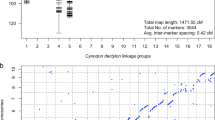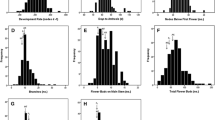Abstract
Genetic mapping using molecular markers such as restriction fragment length polymorphisms (RFLPs) has become a powerful tool for plant geneticists and breeders. Like many economically important polyploid plant species, detailed genetic studies of hexaploid tall fescue (Festuca arundinacea Schreb.) are complicated, and no genetic map has been established. We report here the first tall fescue genetic map. This map was generated from an F2 population of HD28-56 by ‘Kentucky-31’ and contains 108 RFLP markers. Although the two parental plants were heterozygous, the perennial and tillering growth habit, high degree of RFLP, and disomic inheritance of tall fescue enabled us to identify the segregating homologous alleles. The map covers 1274 cM on 19 linkage groups with an average of 5 loci per linkage group (LG) and 17.9 cM between loci. Mapping the homoeologous loci detected by the same probe allowed us to identify five homoeologous groups within which the gene orders were found to be generally conserved among homoeologous chromosomes. An exception was homoeologous group 5, in which only 2 of the 3 homoeologous chromosomes were identified. Using 12 genome-specific probes, we were able to assign several linkage groups to one of the three genomes (PG1G2) in tall fescue. All the loci detected by the 11 probes specific to the G1 and/or G2 genomes, with one exception, identified loci located on 4 chromosomes of two homoeologous groups (LG2a, LG2c, LG3a, and LG3c). A P-genome-specific probe was used to map a locus on LG5c. Comparative genome mapping with maize probes indicated that homoeologous group 3 and 2 chromosomes in tall fescue corresponded to maize chromosome 1. Difficulties and advantages of applying RFLP technology in polyploids with high levels of heterozygosity are discussed.
Similar content being viewed by others
References
Ahn S, Anderson JA, Sorrells ME, Tanksley SD (1994) Homoeologous relationships of rice, wheat, and maize chromosomes. Mol Gen Genet 241:483–490
Anderson JA, Sorrells ME, Tanksley SD (1993) RFLP analysis of genomic regions associated with resistance to preharvest sprouting in wheat. Crop Sci 33:453–459
Beavis WD, Grant D (1991) A linkage map based on information from four F2 populations of maize (Zea mays L.). Theor Appl Genet 82:636–644
Beavis WD, Grant D, Albersten M, Fincher R (1991) Quantitative trait loci for plant height in four maize populations and their associations with qualitative genetic loci. Theor Appl Genet 83:141–145
Bennetzen JL, Freeling M (1993) Grasses as a single genetic systemgenome composition, collinearity and compatibility. Trends Genet 9:259–261
Brummer EC, Bouton JH, Kochert G (1993) Development of an RFLP map in diploid alfalfa. Theor Appl Genet 86:329–332
Chao S, Batsdorfer C, Heredia-Diaz O, Musket T, Xu G, Coe EH Jr (1994) RFLP mapping of partially sequenced leaf cDNA clones in maize. Theor Appl Genet 88:717–721
Dudley JW (1993) Molecular markers in plant improvement: manipulation of genes affecting quantitative traits. Crop Sci 33:660–668
Gardiner JM, Coe EH, Melia-Hancock S, Hoisington DA, Chao S (1993) Development of a core RELP map in maize using an immortalized F2 population. Genetics 134:917–930.
Haldane JBS, Waddington CH (1931) Inbreeding and linkage. Genetics 16:357–374
Kleinhofs A, Kilian A, Saghai Maroof MA, Biyashev RM, Hayes P, Chen FG, Lapitan N, Fenwick N, Blake TK, Kanazin V, Ananiev E, Dahleen L, Kudrna D, Bollinger J, Knapp SJ, Liu B, Sorrells M, Heun M, Franckowiak JD, Hoffman D, Skadsen R, Steffenson BJ (1993) A molecular, isozyme and morphological map of the barley (Hordeum vulgare) genome. Theor Appl Genet 86:705–712
Lander ES, Green P, Abrahamson J, Barlow A, Daly MJ, Lincoln SE, Newburg L (1987) MAPMAKER: An interactive computer package for constructing primary genetic linkage maps of experimental and natural populations. Genomics 1:174–181
Leach C, Hayman DL (1987) The incompatibility loci as indicators of conserved linkage groups in the Poaceae. Heredity 58:303–305
Lewis EJ, Humphreys MW, Caton MP (1980) Disomic inheritance in Festuca arundinacea Schreb. Z Pflanzenzucht 84:335–341
McCouch SR, Kochert G, Yu ZH, Wang ZY, Khush GS, Coffman WR, Tanksley SD (1988) Molecular mapping of rice chromosomes. Theor Appl Genet 76:815–829
Martin GB, Brommonschenkel SH, Chunwongse J, Frary A, Ganal MW, Spivey R, Wu T, Earle ED, Tanksley SD (1993) Map-based cloning of a protein kinase gene conferring disease resistance in tomato. Science 262:1432–1436
Masterson J (1994) Stomatal size in fossil plants: evidence for polyploidy in the majority of angiosperms. Science 264:421–424
Nodari RO, Tsai SM, Gilbertson RL, Gepts P (1993) Towards an integrated linkage map of common bean. 2. Development of an RFLP-based linkage map. Theor Appl Genet 85:513–520
O'Donoughue LS, Souza E, Tanksley SD, Sorrells ME (1994) Relationships among North American oat cultivars based on restriction fragment length polymorphisms. Crop Sci 34:1251–1258
Paterson AH, Lander ES, Hewitt JD, Peterson S, Lincoln SF, Tanksley SD (1988) Resolution of quantitative traits into Mendelian factors by using a complete linkage map of restriction fragment length polymorphisms. Nature 335:721–726
Perira MG, Lee M, Bramel-Cox P, Woodman W, Doebley J, Whitkus R (1994) Construction of an RFLP map in sorghum and comparative mapping in maize. Genome 37:236–243
Seal AG (1983) DNA variation in Festuca. Heredity 50:225–236
Sleper DA (1985) Breeding tall fescue. J Plant Breed Rev 3:313–342
Sorrells ME (1992) Development and application of RFLPs in polyploids. Crop Sci 32:1086–1091
Stebbins GL (1971) Chromosome evolution in higher plants. Columbia University Press, New York
Wang GL, Mackill DJ, Bonman JM, McCouch SR, Champoux MC, Nelson RJ (1994) RFLP mapping of genes conferring complete and partial resistance to blast in a durably resistant rice cultivar. Genetics 136:1421–1434
Wu KK, Burnquist W, Sorrells ME, Tew TL, Moore PH, Tanksley SD (1992) The detection and estimation of linkage in polyploids using single-dose restriction fragments. Theor Appl Genet 83:294–300
Xu WW, Sleper DA, Hoisington DA (1991) A survey of restriction fragment length polymorphisms in tall fescue and its relatives. Genome 34:686–692
Xu WW, Sleper DA, Krause GF (1994) Genetic diversity of tall fescue germplasm based on RFLPs. Crop Sci 34:246–252
Author information
Authors and Affiliations
Additional information
Communicated by G. E. Hart
Journal Series No. 12, 190
Rights and permissions
About this article
Cite this article
Xu, W.W., Sleper, D.A. & Chao, S. Genome mapping of polyploid tall fescue (Festuca arundinacea Schreb.) with RFLP markers. Theoret. Appl. Genetics 91, 947–955 (1995). https://doi.org/10.1007/BF00223905
Received:
Accepted:
Issue Date:
DOI: https://doi.org/10.1007/BF00223905




